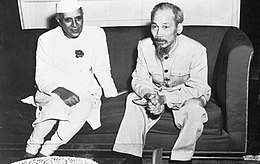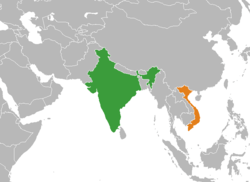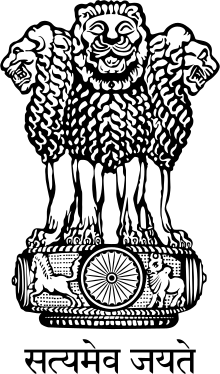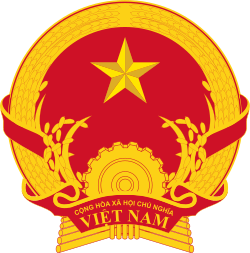India–Vietnam relations
The Republic of India and the Socialist Republic of Vietnam enjoy strong bilateral relations.

 | |
India |
Vietnam |
|---|---|
| Diplomatic mission | |
| New Delhi (Vietnamese Embassy) | Hanoi (Indian Embassy) |
Cultural and economic links between India and Vietnam date back to 2nd century.[1] The Indic Chăm Pa kingdom had some influence on Vietnamese music.[1] In contemporary era, relations between India and Vietnam have been governed by several areas of shared political interests.[2] India strongly condemned U.S. action during the Vietnam War and was also one of the few non-communist countries to assist Vietnam during the Cambodian–Vietnamese War.[2]
In 1992, India and Vietnam established extensive economic ties, including oil exploration, agriculture and manufacturing.[2] The relations between the two countries, especially defence ties, benefited extensively from India's Look East policy.[3] Bilateral military cooperation includes sale of military equipment, sharing of intelligence, joint naval exercises and training in counterinsurgency and jungle warfare.[4] India also regularly deploys its warships for goodwill visits to Vietnamese seas.
Background
India supported Vietnam's independence from France, opposed American involvement in the Vietnam War, and supported unification of Vietnam. During the Vietnam War, India supported the North, albeit not by conducting military hostilities against the South. This can be contrasted with the policies of the US, who strongly supported the South and engaged in military conflict with the North, albeit without issuing an official declaration of war.
India and North Vietnam established official diplomatic relations in 1972 and have since maintained friendly relations, especially in wake of Vietnam's hostile relations with the People's Republic of China, with which India had some diplomatic disputes.[5]
Development of bilateral and commercial ties

India granted the "Most Favoured Nation" status to Vietnam in 1975[5] and both nations signed a bilateral trade agreement in 1978 and the Bilateral Investment Promotion and Protection Agreement (BIPPA) on March 8, 1997.[6] The Indo-Vietnam Joint Business Council has worked to promote trade and investment since 1993. In 2003, both nations promulgated a Joint Declaration on Comprehensive Cooperation when the General Secretary of the Communist Party of Vietnam Nông Đức Mạnh visited India and both nations are negotiating a free trade agreement.[5][7][8] In 2007, a fresh joint declaration was issued during the state visit of the Prime Minister of Vietnam Nguyễn Tấn Dũng.[9] Bilateral trade has increased rapidly since the liberalisation of the economies of both Vietnam and India.[5] India is the 13th-largest exporter to Vietnam, with exports that have grown steadily from $11.5 million in 1985-86 to $395.68 million by 2003.[6] Vietnam's exports to India rose to $180 million, including agricultural products, handicrafts, textiles, electronics and other goods.[10] Between 2001 and 2006, the volume of bilateral trade expanded at 20-30% per annum to reach US$1 billion by 2006.[7][11] Continuing the rapid pace of growth, bilateral trade is expected to rise to $2 billion by 2008, 2 years ahead of the official target.[8][11] India and Vietnam have also expanded cooperation in information technology, education and collaboration of the respective national space programmes.[9] Direct air links and lax visa regulations have been established to bolster tourism.[12]
In 2010, as the ASEAN-India free trade agreement came into effect, bilateral trade exploded to US$3.917 billion by the end of 2012, with Vietnam exporting $1.7 billion to India in 2012, an increase of 56.5% from 2011.[13][14] As of 2015 bilateral trade stands at US$7 billion & both nations have agreed on a target of US$20 billion by 2020.
The PRC has complained about Indian cooperation for the exploration for oil in Vietnamese waters,[15] especially in light of the disputed political status of the Spratly Islands, and other nearby island chains, which India currently recognises as part of Vietnam.
Strategic cooperation
.jpg)
In January 2000, the Indian Defence Minister, George Fernandes, called for a renewed political relationship with Vietnam, describing Vietnam as India's most trusted friend and ally. He proposed that India should develop a naval presence in the South China Sea through access to the Cam Ranh Bay naval and air base and that India should provide training and advanced weapons to Vietnam.[16]
India and Vietnam are both members of the Mekong–Ganga Cooperation, created to develop and enhance close ties between India and nations of Southeast Asia. Vietnam has supported India's bid to become a permanent member of the U.N. Security Council and join the Asia-Pacific Economic Cooperation (APEC).[17] In the 2003 joint declaration, India and Vietnam envisaged creating an "Arc of Advantage and Prosperity" in Southeast Asia;[9] to this end, Vietnam has backed increasing the significance of the relationship between India and the Association of Southeast Asian Nations (ASEAN) and its negotiation of an Indo-ASEAN free trade agreement.[5][9] India and Vietnam have also built strategic partnerships, including extensive cooperation on developing nuclear power, enhancing regional security and fighting terrorism, transnational crime and drug trafficking.[9][10][18]
Vietnam has also welcomed Indian Navy ships in their region which would enhance India and Vietnam military relations.[19] Vietnam has also welcomed Indian support for a peaceful resolution of the territorial disputes in the South China Sea.[20] Indian Foreign Minister Salman Khurshid has called Vietnam one of the pillars of India’s "Look East" policy.[21] In 2018, India and Vietnam are scheduled to conduct their first bilateral naval exercise together, in Vietnamese waters.[22]
India is providing training support for Vietnam's Kilo-class submarines.[23] India has also offered to train Vietnamese pilots to fly Sukhoi aircraft.
India is providing a $100 million credit line to Vietnam, that allows Vietnam to buy defence equipment from India. During his visit to Vietnam, on 2 September 2016, India's Prime Minister Narendra Modi announced a new line of credit US$500 million for procurement of defence equipment. India is selling Vietnam four large patrol vessels that will enable Vietnam to patrol its waters and Vietnam is also interested in buying BrahMos short range cruise missiles.[24]
India is setting up the Satellite Tracking and Imaging Centre by Indian Space Research Organisation in Southern Vietnam for intelligence gathering to keep an eye on China.[25][26] Recently, Indian army personnel have provided training for Vietnamese military personnel to work in the UN peacekeeping force.
Diplomatic missions
|
|
Bibliography
- Lokesh, Chandra, & International Academy of Indian Culture. (2000). Society and culture of Southeast Asia: Continuities and changes. New Delhi: International Academy of Indian Culture and Aditya Prakashan.
- Cœdès, George (1968). Walter F. Vella (ed.). The Indianized States of Southeast Asia. trans.Susan Brown Cowing. University of Hawaii Press. ISBN 978-0-8248-0368-1.CS1 maint: ref=harv (link)
- R. C. Majumdar, Study of Sanskrit in South-East Asia
- R. C. Majumdar, Champa, Ancient Indian Colonies in the Far East, Vol.I, Lahore, 1927. ISBN 0-8364-2802-1
- R. C. Majumdar, Suvarnadvipa, Ancient Indian Colonies in the Far East, Vol.II, Calcutta,
- R. C. Majumdar, Kambuja Desa Or An Ancient Hindu Colony In Cambodia, Madras, 1944
- R. C. Majumdar, Hindu Colonies in the Far East, Calcutta, 1944, ISBN 99910-0-001-1
- R. C. Majumdar, India and South-East Asia, I.S.P.Q.S. History and Archaeology Series Vol. 6, 1979, ISBN 81-7018-046-5.
- R. C. Majumdar, Ancient Indian colonisation in South-East Asia; History of the Hindu Colonization and Hindu Culture in South-East Asia
- Daigorō Chihara (1996). Hindu-Buddhist Architecture in Southeast Asia. BRILL. ISBN 90-04-10512-3.
- Sharma, Geetesh. India-Vietnam Relations : First to Twenty-First Century. Kolkata, Dialogue Society, 2004
References
- Sharma, Geetesh (2010). Trace of Indian Culture in Vietnam. Rajkamal Prakashan. ISBN 9788190540148.
- Frost, Frank (1993). Vietnam's foreign relations: dynamics of change. Institute of Southeast Asian. ISBN 9789813016651.
- Nanda, Prakash (2003). Rediscovering Asia: evolution of India's look-east policy. Lancer Publishers. ISBN 9788170622970.
- Blank, Stephen. Natural Allies?: Regional Security in Asia and Prospects for Indo-American Strategic Cooperation. DIANE Publishing.
- "India and Vietnam in changing East Asia". Institute of Peace and Conflict Studies. Retrieved 2008-06-16.
- "India - Vietnam Economic and Commercial Relations". Federation of Indian Chambers of Commerce and Industry. Archived from the original on December 10, 2007. Retrieved 2008-06-16.
- "Vietnam favours FTA with India". The Hindu. 2007-07-07. Retrieved 2008-06-16.
- "Trade with India to reach US$2 billion in 2008". Vietnam Business Finance. 2008-05-03. Archived from the original on 2008-05-05. Retrieved 2008-06-16.
- "Vietnam, India issue joint declaration on strategic partnership". VietNamNet Bridge. Archived from the original on 2008-12-16. Retrieved 2008-06-16.
- "India-Vietnam: Developing a Strategic Partnership" (PDF). Asian Affairs. Retrieved 2008-06-16.
- "Vietnam PM urges greater trade ties with India". The Hindu Business Line. 2007-07-07. Retrieved 2008-06-16.
- "India, Vietnam to start direct flights". The Hindu Business Line. 2004-10-18. Retrieved 2008-06-16.
- "Tạp chí Cộng Sản - Xuất, nhập khẩu của Việt Nam năm 2012 - kết quả và những vấn đề đặt ra". Archived from the original on 2014-11-06.
- "Tap chi kinh te du bao". Archived from the original on 2013-04-21.
- Cheng, Dean. "China Grows More Belligerent, Unexpectedly." Archived 2012-04-25 at the Wayback Machine Aol Defense, 5 October 2011.
- David Brewster. "India as an Asia Pacific Power. Retrieved 19 August 2014".
- "Vietnam backs India for APEC membership". The Hindu. 2000-11-07. Archived from the original on 2008-12-16. Retrieved 2008-06-16.
- "India, Vietnam sign MoU for bilateral cooperation on security". Times of India. 2008-03-24. Retrieved 2008-06-16.
- "Vietnam counters Chinese aggression". The times of India. 2 Sep 2011. Archived from the original on 26 August 2014. Retrieved September 2, 2011.
- "South China Sea: Vietnam sees greater Indian role." Zee News, 7 July 2012.
- "Vietnam among pillars of India's "Look East" policy". english.vietnamnet.vn. Vietnam News Agency. 18 November 2013. Retrieved 18 November 2013.
- Banerjee, Ajay (May 14, 2018). "India, Vietnam gear up for first naval drill in China backyard". The Tribune.
A flotilla of three Indian warships — INS Shayadri, INS Kamorta and INS Shakti — is on its way to Vietnam, sources said while confirming the first-ever bilateral exercise at sea.
- Thayer, Carl (September 29, 2014). "Can Vietnam's Maritime Strategy Counter China?". thediplomat.com. The Diplomat. Retrieved 5 October 2014.
- Bagchil, Indrani (29 October 2014). "India ignores China's frown, offers defence boost to Vietnam". Times of India. Bennett, Coleman & Co. Retrieved 30 October 2014.
- "India to build satellite tracking station in Vietnam that offers eye on China.", Reuters, 25 January 2016.
- Overseas Military Bases of Indian Archived 2017-07-31 at the Wayback Machine, Defence News.

